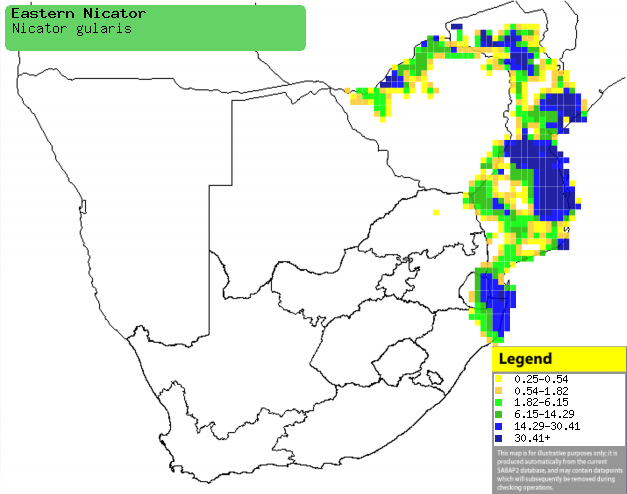|
Nicator gularis (Eastern
nicator, Yellow-spotted nicator)
Geelvleknikator [Afrikaans]; Bruinkopnicator [Dutch];
Bulbul à tête brune [French]; Bülbülwürger [German]; Tuta-malhada
[Portuguese]
Life
> Eukaryotes >
Opisthokonta
> Metazoa (animals) >
Bilateria >
Deuterostomia > Chordata >
Craniata > Vertebrata (vertebrates) > Gnathostomata (jawed
vertebrates) > Teleostomi (teleost fish) > Osteichthyes (bony fish) > Class:
Sarcopterygii (lobe-finned
fish) > Stegocephalia (terrestrial
vertebrates) > Tetrapoda
(four-legged vertebrates) > Reptiliomorpha > Amniota >
Reptilia (reptiles) >
Romeriida > Diapsida > Archosauromorpha > Archosauria >
Dinosauria
(dinosaurs) > Saurischia > Theropoda (bipedal predatory dinosaurs) >
Coelurosauria > Maniraptora > Aves
(birds) > Order: Passeriformes
> Family: Pycnonotidae
For information about this species, see
birdinfo.co.za.
Distribution and habitat
Occurs in the lowlands of East Africa, extending from Kenya
to northern Mozambique and Zambia, south to southern Africa. Here it is uncommon
and retiring, silently descending to the undergrowth if disturbed although it
sometimes perches prominently near its nest to call. It is found across
Mozambique, Swaziland, northern and south-eastern Zimbabwe, eastern Limpopo
Province and KwaZulu-Natal. It generally prefers lowland secondary, evergreen
and coastal forest, dense undergrowth of miombo (Brachystegia) woodland,
moist thornveld and riverine forest.
|
 |
|
Distribution of Eastern nicator in southern
Africa, based on statistical smoothing of the records from first SA Bird
Atlas Project (©
Animal Demography unit, University of
Cape Town; smoothing by Birgit Erni and Francesca Little). Colours range
from dark blue (most common) through to yellow (least common).
See here for the latest distribution
from the SABAP2. |
Classification
The source of much debate, it is has been placed with the
bush-shrikes (Malaconotidae) and with
bulbuls (Pycnonotidae). As it resembles both of these
families in many aspects, it might also be best to place it in its own family.
Food
It eats insects, mainly foraging in the tree canopy,
gleaning prey from leaves and branches while occasionally flicking its wings. It
may also descend to the ground to feed, occasionally plucking ectoparasites from
large mammals or hawking the insects they disturb. The following food items have been recorded
in its diet:
- grasshoppers (Orthoptera)
-
mantids
- skinks (Scincidae)
-
caterpillars (larval stage of
Lepidoptera)
- ticks, taken off mammals such as:
- Phacochoerus aethiopicus (Warthog)
- Tragelaphus angasii (Nyala)
- Aepyceros melamphus (Impala)
- Equus burchelli (Burchell's zebra)
- Cephalophus natalensis (Red duiker)
Breeding
- The nest (see images below) is an untidy platform of twigs, tendrils and
stalks
Threats
Not threatened.
References
-
Hockey PAR, Dean WRJ and Ryan PG 2005. Roberts
- Birds of southern Africa, VIIth ed. The Trustees of the John Voelcker
Bird Book Fund, Cape Town.
-
H. Chittenden and G. Upfold. 2008. Eastern Nicator.
[Online] (Updated 14 June 2008)
Available at:
http://www.birdinfo.co.za/landbirds/45_eastern_nicator.htm [Accessed 12
March 2009].
|
